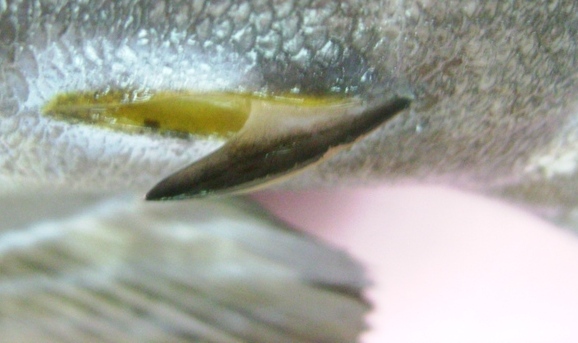Acanthurinae on:
[Wikipedia]
[Google]
[Amazon]
''Acanthurinae'' is a
 Acanthurini surgeonfishes are characterised by having 3 spines in the
Acanthurini surgeonfishes are characterised by having 3 spines in the
subfamily
In biological classification, a subfamily (Latin: ', plural ') is an auxiliary (intermediate) taxonomic rank, next below family but more inclusive than genus. Standard nomenclature rules end botanical subfamily names with "-oideae", and zo ...
of marine ray-finned fish
Actinopterygii (; ), members of which are known as ray-finned fish or actinopterygians, is a class of bony fish that comprise over 50% of living vertebrate species. They are so called because of their lightly built fins made of webbings of sk ...
es belonging to the family
Family (from ) is a Social group, group of people related either by consanguinity (by recognized birth) or Affinity (law), affinity (by marriage or other relationship). It forms the basis for social order. Ideally, families offer predictabili ...
Acanthuridae
Acanthuridae are a family of ray-finned fish which includes surgeonfishes, tangs, and unicornfishes. The family includes about 86 extant species of marine fish living in tropical seas, usually around coral reefs. Many of the species are brigh ...
, found in the Indo-Pacific
The Indo-Pacific is a vast biogeographic region of Earth. In a narrow sense, sometimes known as the Indo-West Pacific or Indo-Pacific Asia, it comprises the tropical waters of the Indian Ocean, the western and central Pacific Ocean, and the ...
and the tropical Atlantic. These fishes commonly have the English names surgeonfishes or tangs.
Taxonomy
Acanthurinae is the nominate subfamily of the family Acanthuridae which was proposed by the Frenchzoologist
Zoology ( , ) is the scientific study of animals. Its studies include the structure, embryology, classification, habits, and distribution of all animals, both living and extinct, and how they interact with their ecosystems. Zoology is one ...
Charles Lucien Bonaparte
Charles Lucien Jules Laurent Bonaparte, 2nd Prince of Canino and Musignano (24 May 1803 – 29 July 1857) was a French naturalist and ornithology, ornithologist, and a nephew of Napoleon. Lucien and his wife had twelve children, including Cardinal ...
in 1835. The 5th edition of ''Fishes of the World
''Fishes of the World'' is a standard reference for the systematics of fishes. It was first written in 1976 by the American ichthyologist Joseph S. Nelson (1937–2011). Now in its fifth edition (2016), the work is a comprehensive overview of t ...
'' recognises 3 tribes
The term tribe is used in many different contexts to refer to a category of human social group. The predominant worldwide use of the term in English is in the discipline of anthropology. The definition is contested, in part due to conflict ...
within the subfamily, the Acanthurini, Prionurini and Zebrasomoni. The other subfamily in the Acanthuridae is the monogeneric
In biology, a monotypic taxon is a taxonomic group (taxon) that contains only one immediately subordinate taxon. A monotypic species is one that does not include subspecies or smaller, infraspecific taxa. In the case of genera, the term "unispe ...
Nasinae
''Naso'' is a genus of marine ray-finned fishes belonging to the family, Acanthuridae, the unicornfishes, surgeonfishes and tangs. The fishes in this genus are known commonly as unicornfishes because of the "rostral protuberance", a hornlike exte ...
.
Tribes and genera
Acanthurinae is subdivided into the following tribes and genera: ''FishBase
FishBase is a global species database of fish species (specifically finfish). It is the largest and most extensively accessed online database on adult finfish on the web.
'' list 57 species in the subfamily, with ''Acanthurus'' containing 40 species being the most speciose genus.
Characteristics
 Acanthurini surgeonfishes are characterised by having 3 spines in the
Acanthurini surgeonfishes are characterised by having 3 spines in the anal fin
Fins are moving appendages protruding from the body of fish that interact with water to generate thrust and help the fish swim. Apart from the tail or caudal fin, fish fins have no direct connection with the back bone and are supported o ...
. They also have one or more mobile and flexible
spine on the caudal peduncle
Fins are moving appendages protruding from the body of fish that interact with water to generate thrust and help the fish swim. Apart from the tail or caudal fin, fish fins have no direct connection with the back bone and are supported only ...
, this spine is not mobile in ''Prionurus
''Prionurus'' is a genus of marine ray-finned fishes belonging to the family Acanthuridae, the surgeonfishes, unicornfishes and tangs, although some of the species in this genus are called sawtails or doctorfish. The species in this genus are fou ...
'', that may be extended as a defensive weapon. In the tribe Acanthurini this spine is held in a deep slit. They have 5 branchiostegals and they have spatulate teeth in the jaws. The smallest species is the bluebarred surgeonfish ('' Acanthurus polyzona'') with a maximum published total length of while the largest species, Fowler's surgeonfish ('' A. folweri'') and the powderblue surgeonfish ('' A. leucosternon''), both have maximum published total length
Fish measurement is the measuring of individual fish and various parts of their anatomies, for data used in many areas of ichthyology, including taxonomy and fishery biology.
Overall length
Standard length (SL) is the length of a fish measured f ...
s of .
Distribution
Acanthurinae are mainly found in the Indo-Pacific region but five species in the genus ''Acanthurus'' extend into the tropical and subtropical Atlantic Ocean but they are absent from the Mediterranean.References
Bibliography
* Joseph S. Nelson: ''Fishes of the World.'' John Wiley & Sons, 2006, * André Luty: ''Doktorfische - Lebensweise - Pflege - Arten.'' Dähne Verlag, Ettlingen 1999, * Andreas Vilcinskas: ''Meerestiere der Tropen'', Franckh-Kosmos Verlag, Stuttgart 2000, * Helmut Debelius und Rudie H. Kuiter: ''Doktorfische und ihre Verwandten.'' Ulmer Verlag Stuttgart 2002, {{Taxonbar, from=Q2291438 Acanthuridae Ray-finned fish subfamilies